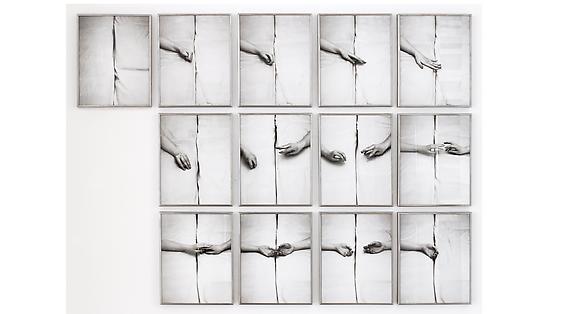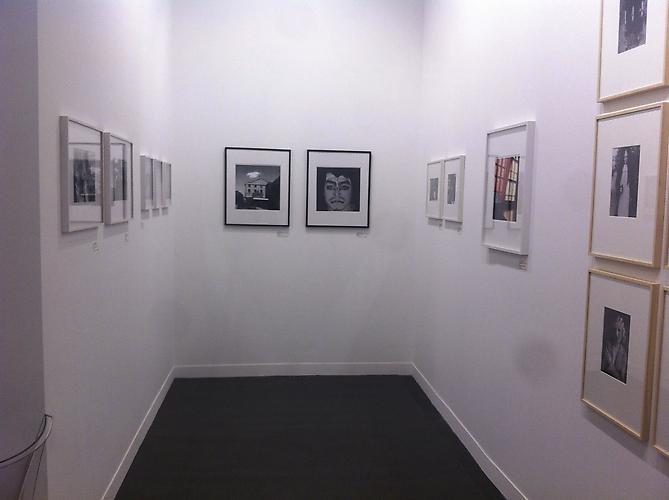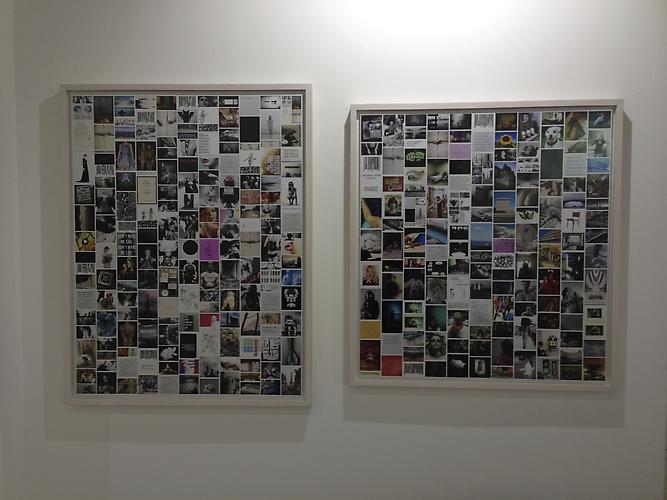PARIS PHOTO
Grand Palais | 2012
November 14th – November 17th, 2012
For this year’s Art Paris, Priska Pasquer presents a selection of works in various media, made by artists from Japan, the USA, and Germany. Apart from the essential criterion of high artistic quality, the selection focuses on the complexity of formal expression, from traditional subjects such as portrait and landscape to abstraction, occasionally emphasizing reflections and parallelisms that serve to stimulate the curiosity of the viewer. The artists represented are all established masters of their trade, and their works demonstrate their abilities most clearly.
“Marine 10 AM 2” (2007) is a perfectly reduced seascape by the American painter Alex Katz illustrates his familiarity with the great American tradition of Color Field Painting, fueled by his own personal poetry and his impeccable style. The purist landscape photographs by Rinko Kawauchi are a subtle echo to Katz. Andy Warhol’s late portrait of the androgynous and enigmatic Jacques Bellini with its sense of urban glamour sets an appropriate contrast (echoed again by the photographs ofNobuyoshi Araki, Daido Moriyama).
The American artist Sherrie Levine – honored earlier this year with a substantial exhibition at the Whitney Museum of American Art in New York – is present with a series of photographic prints after Cezanne and two sculpture groups that permit a more comprehensive understanding of this fascinating artist whose investigation is more fundamental than just being a postmodern appropriationist. Her work poses existential questions, and the formal perfection of her objects is charged with a sublime sense of desire and eroticism. The “Three Furies” are perfectly cast bronzes from old branches that create affinities to strange, living creatures – a double game of suggestion, imagination and obsession whose originator remains elusive. The child’s head of “L’enfant juif” forms a stark contrast to Leiko Ikemura’s terracotta head with its associations to old age and archaeological findings.
The works of Rudolf Bonvie and Philip Taaffe form a surprising, yet logical couple. Both are the result of a conscious analysis of Arabic ornament, mirroring and reflecting the complex relation between abstraction and image in various broken and multilayered ways. The works of both artists – the German Rudolf Bonvie, who works with photography, and the American painter Philip Taaffe – allows deeper insights underneath a deceptively decorative and seductive surface, where an enormous depth of aesthetic thought reveals itself.
The works of the Japanese photographers Nobuyoshi Araki,Daido Moriyama, Issei Suda, Shomei Tomatsu und Shin Yanagisawa allow glimpses into yet another, private, sensual and intimate world, appealing simultaneously to the viewer’s voyeurism and his ethical sense. By contrast, Yutaka Takanashi depicts an industrialized world, which slowly becomes uninhabitable for humans.
For this year’s Art Paris, Priska Pasquer presents a selection of works in various media, made by artists from Japan, the USA, and Germany. Apart from the essential criterion of high artistic quality, the selection focuses on the complexity of formal expression, from traditional subjects such as portrait and landscape to abstraction, occasionally emphasizing reflections and parallelisms that serve to stimulate the curiosity of the viewer. The artists represented are all established masters of their trade, and their works demonstrate their abilities most clearly.
“Marine 10 AM 2” (2007) is a perfectly reduced seascape by the American painter Alex Katz illustrates his familiarity with the great American tradition of Color Field Painting, fueled by his own personal poetry and his impeccable style. The purist landscape photographs by Rinko Kawauchi are a subtle echo to Katz. Andy Warhol’s late portrait of the androgynous and enigmatic Jacques Bellini with its sense of urban glamour sets an appropriate contrast (echoed again by the photographs ofNobuyoshi Araki, Daido Moriyama).
The American artist Sherrie Levine – honored earlier this year with a substantial exhibition at the Whitney Museum of American Art in New York – is present with a series of photographic prints after Cezanne and two sculpture groups that permit a more comprehensive understanding of this fascinating artist whose investigation is more fundamental than just being a postmodern appropriationist. Her work poses existential questions, and the formal perfection of her objects is charged with a sublime sense of desire and eroticism. The “Three Furies” are perfectly cast bronzes from old branches that create affinities to strange, living creatures – a double game of suggestion, imagination and obsession whose originator remains elusive. The child’s head of “L’enfant juif” forms a stark contrast to Leiko Ikemura’s terracotta head with its associations to old age and archaeological findings.
The works of Rudolf Bonvie and Philip Taaffe form a surprising, yet logical couple. Both are the result of a conscious analysis of Arabic ornament, mirroring and reflecting the complex relation between abstraction and image in various broken and multilayered ways. The works of both artists – the German Rudolf Bonvie, who works with photography, and the American painter Philip Taaffe – allows deeper insights underneath a deceptively decorative and seductive surface, where an enormous depth of aesthetic thought reveals itself.
The works of the Japanese photographers Nobuyoshi Araki,Daido Moriyama, Issei Suda, Shomei Tomatsu und Shin Yanagisawa allow glimpses into yet another, private, sensual and intimate world, appealing simultaneously to the viewer’s voyeurism and his ethical sense. By contrast, Yutaka Takanashi depicts an industrialized world, which slowly becomes uninhabitable for humans.







